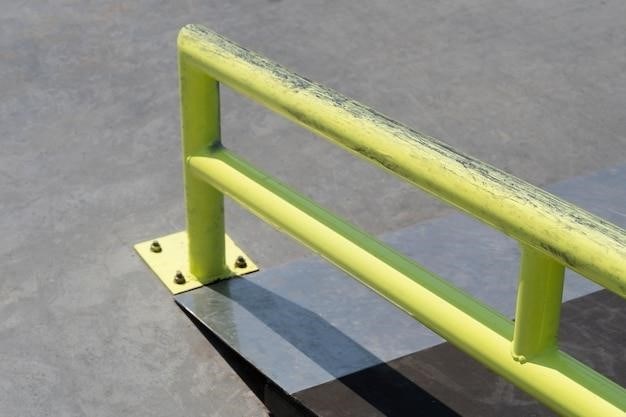Sliding Gate Guide Rollers⁚ Essential Components for Smooth Operation
Sliding gate guide rollers are crucial components that ensure smooth, reliable operation of sliding gates. These rollers, typically made of durable materials like nylon or steel, are designed to guide the gate along its track, preventing it from derailing or becoming misaligned. They are essential for both residential and commercial sliding gates, ensuring ease of use and longevity.
Introduction
Sliding gates are a popular choice for securing properties and enhancing curb appeal, offering a seamless and efficient way to control access. While the gate itself is a prominent feature, its smooth and reliable operation hinges on a critical element⁚ the guide rollers. These unassuming components play a vital role in ensuring the gate’s stability, preventing it from swaying or derailing as it opens and closes. Sliding gate guide rollers are not just a functional necessity; they are essential for a gate’s long-term performance and user experience.
Imagine a sliding gate that jerks and grinds as you try to open it, or one that suddenly veers off its track, causing damage or potential safety hazards. This is where guide rollers step in. They provide the necessary support and guidance, enabling the gate to move smoothly and effortlessly along its designated path. Guide rollers are designed to withstand the weight of the gate, the forces of opening and closing, and the elements that may cause wear and tear over time. They come in various sizes and materials, tailored to suit different gate styles, track configurations, and environmental conditions.
This guide will delve into the world of sliding gate guide rollers, exploring their types, benefits, and factors to consider when choosing the right ones for your specific gate. We’ll also discuss installation and maintenance tips to ensure optimal performance and longevity of your gate’s essential guide rollers.
Types of Sliding Gate Rollers
Sliding gate guide rollers come in a variety of types, each designed to meet specific needs and applications. Understanding the different types available allows you to choose the most suitable option for your gate and ensure optimal performance.
Nylon Rollers⁚ Nylon rollers are a popular choice due to their durability, resistance to corrosion, and smooth operation. They are often used for residential gates and are generally quieter than steel rollers. Nylon rollers are available in various sizes and configurations, with different bearing systems for enhanced load capacity.
Steel Rollers⁚ Steel rollers offer exceptional strength and durability, making them ideal for heavy-duty gates and commercial applications. They are often used in environments with high traffic or where resistance to wear and tear is paramount. Steel rollers are typically available in a variety of finishes, such as galvanized or powder-coated, to enhance corrosion resistance.
Rubberized Rollers⁚ Rubberized rollers provide a combination of durability and noise reduction. They are often used in applications where noise control is a concern, such as residential areas or near noise-sensitive environments. The rubber coating helps to absorb vibrations and minimize noise during gate operation.
UHMW (Ultra-High Molecular Weight Polyethylene) Rollers⁚ UHMW rollers are known for their exceptional wear resistance, low friction, and excellent chemical resistance. They are particularly well-suited for applications with high wear and tear, such as industrial settings or gates exposed to harsh weather conditions.
The specific type of roller you choose will depend on the size, weight, and frequency of use of your gate, as well as the environment in which it operates. It’s essential to select rollers that are compatible with your gate’s track and construction.
Guide Rollers for Different Gate Styles
The type of guide roller required for a sliding gate depends heavily on the gate’s style and design. Different gate styles necessitate specific roller configurations to ensure proper operation and stability. Understanding these variations is crucial for selecting the right guide rollers for your specific gate.
Flat Gates⁚ Flat gates, typically used for residential or smaller applications, often require a minimum of 3 guide rollers. These rollers are positioned along the track, providing stability and preventing the gate from swaying or tilting. The number of rollers can be increased depending on the gate’s length and weight.
Curved Gates⁚ Curved gates, such as arched or bell-shaped gates, require more guide rollers to maintain stability throughout the opening and closing cycle. These gates often utilize a greater number of rollers, with the exact quantity determined by the curvature and length of the gate.
Cantilever Gates⁚ Cantilever gates, which extend beyond the opening and are supported by rollers mounted on a cantilevered arm, require specific guide rollers designed for this type of construction; These rollers are often larger and heavier than those used for traditional sliding gates to handle the increased weight and forces involved.
Ground Track Gates⁚ Ground track gates, where the gate slides along a track embedded in the ground, require specific guide rollers that fit the track profile. These rollers are often made of durable materials like nylon or UHMW to resist wear and tear from contact with the track.
The choice of guide rollers for different gate styles is essential for ensuring smooth, reliable operation and preventing damage to the gate or track. Consulting a professional or gate specialist can help determine the appropriate roller configuration for your specific gate type.
Benefits of Using Guide Rollers
Sliding gate guide rollers offer numerous benefits that contribute to the smooth, reliable, and long-lasting performance of sliding gates. These benefits make guide rollers an essential component for both residential and commercial gate systems.
Smooth Operation⁚ Guide rollers ensure a smooth and effortless gate operation. They eliminate friction between the gate and the track, allowing for easy opening and closing, even with heavy gates. This ease of movement contributes to a more pleasant user experience and reduces wear and tear on the gate and track.
Stability and Alignment⁚ Guide rollers play a crucial role in maintaining gate stability and alignment. They keep the gate securely positioned on the track, preventing it from swaying or tilting, especially during windy conditions. This stability ensures smooth movement and prevents damage to the gate or track due to misalignment.
Reduced Wear and Tear⁚ By minimizing friction and maintaining alignment, guide rollers contribute to reduced wear and tear on the gate and track. This extended lifespan reduces the need for costly repairs or replacements, making guide rollers a cost-effective investment in the long run.
Increased Durability⁚ Guide rollers, often made of durable materials like nylon or steel, are designed to withstand the rigors of repeated use. This durability ensures that the rollers will continue to perform reliably for years to come, providing a long-lasting solution for your gate system.
Safety and Security⁚ Well-functioning guide rollers contribute to a safer and more secure gate system. They ensure that the gate operates smoothly and predictably, reducing the risk of accidents or malfunctions. This is particularly important for gates that provide security or access control.
In conclusion, the benefits of using guide rollers on sliding gates are numerous and significant. From ensuring smooth operation to enhancing durability and safety, guide rollers are an essential investment for maintaining the performance and longevity of your gate system.
Choosing the Right Guide Rollers
Selecting the right guide rollers for your sliding gate is crucial for ensuring smooth, reliable operation and a long lifespan for your gate system. Several factors need to be considered when choosing the best guide rollers for your specific needs.
Roller Size and Material⁚ The size of the roller should match the weight and size of your gate. Larger gates will require larger rollers to handle the additional load. The material of the roller also plays a significant role in its performance and longevity. Nylon rollers are often preferred for their durability, resistance to corrosion, and low friction properties. Steel rollers, while heavier, can offer greater strength and longevity, especially for heavier gates.
Bracket Type and Mounting⁚ The type of bracket used to mount the roller will depend on the design of your gate and track system. L-shaped brackets are common for mounting on the rear post of the gate, while C-shaped brackets are often used for mounting on the track itself. Adjustable brackets allow for fine-tuning the roller position for optimal alignment.
Number of Rollers⁚ The number of rollers required will depend on the length and weight of the gate, as well as the curvature of the track. Longer or heavier gates will require more rollers to distribute the weight and ensure smooth movement. Gates with a curved track may need additional rollers to maintain alignment and prevent the gate from derailing.
Compatibility⁚ Ensure that the chosen guide rollers are compatible with your existing gate and track system. Consider factors like the track width, the type of mounting system, and the overall design of your gate. Checking compatibility beforehand can save you time and frustration during installation.
By carefully considering these factors, you can select the right guide rollers to ensure that your sliding gate operates smoothly, reliably, and safely for years to come. Choosing the right guide rollers will help you make the best possible investment in your gate system.
Roller Size and Material
The size and material of your sliding gate guide rollers are crucial factors in determining their performance and longevity. Matching the roller size to the weight and size of your gate is essential for ensuring smooth operation and preventing premature wear.
Roller Size⁚ Larger gates, with their increased weight and surface area, demand larger rollers to distribute the load effectively. Smaller rollers may struggle to handle the stress, leading to premature wear and tear, potentially causing the gate to derail or become difficult to operate. For lighter, smaller gates, smaller rollers may suffice, but it’s always best to err on the side of caution and choose a slightly larger roller for added durability.
Roller Material⁚ The material used for the rollers significantly impacts their performance and lifespan. Common choices include nylon, steel, and rubberized hard plastic, each offering unique advantages and disadvantages.
Nylon⁚ Nylon rollers are renowned for their durability, resistance to corrosion, and low friction properties. They are relatively lightweight, making them ideal for lighter gates. However, they may not be as robust as steel rollers for heavy-duty applications.
Steel⁚ Steel rollers offer greater strength and longevity, making them well-suited for heavier gates. They are also more resistant to wear and tear, especially in demanding environments. However, steel rollers can be heavier and more susceptible to corrosion if not properly protected.
Rubberized Hard Plastic⁚ Rubberized hard plastic rollers offer a combination of durability and noise reduction. They are often used in residential applications where quiet operation is desired. However, they may not be as robust as nylon or steel rollers for heavy-duty use.
Choosing the right roller size and material for your specific gate and operating conditions is crucial for ensuring smooth, reliable operation and a long lifespan for your gate system. Consider the weight of your gate, the frequency of use, and the environmental conditions when selecting the best rollers for your needs.
Bracket Type and Mounting

The bracket type and mounting method for your sliding gate guide rollers are equally important in ensuring proper alignment, stability, and ease of installation. Choosing the right bracket and mounting technique for your specific gate and installation conditions is crucial for a secure and functional setup.
Bracket Types⁚ Two common bracket types for sliding gate rollers are L-shaped brackets and C-shaped brackets. Both types have their strengths and weaknesses, making the choice dependent on the gate’s design, installation requirements, and personal preference.
L-Shaped Brackets⁚ L-shaped brackets offer greater versatility and adjustability. They are typically mounted to the rear post of the gate, allowing for vertical and horizontal adjustment to fine-tune the roller’s position. This versatility makes them suitable for gates with varying levels of ground unevenness or gates requiring precise alignment.
C-Shaped Brackets⁚ C-shaped brackets are generally more rigid and secure, designed for mounting directly to the gate itself. They offer less adjustability than L-shaped brackets, so they are often used in applications where precise alignment is less critical or where the gate has a uniform structure.
Mounting Methods⁚ Guide roller brackets can be mounted using various methods, including bolting, welding, or a combination of both. Bolting provides flexibility for adjustments and ease of removal, while welding offers greater rigidity and permanence.
Bolting⁚ Bolting the bracket to the gate or post allows for adjustments to fine-tune the roller’s position and is ideal for installations where adjustments may be required in the future. However, the bolts must be securely fastened to prevent loosening and potential safety hazards.
Welding⁚ Welding the bracket to the gate or post offers a permanent, highly rigid connection. This is a suitable method for gates that require a strong, stable connection and are not likely to require adjustments;
Choosing the appropriate bracket type and mounting method for your gate will ensure proper alignment, stability, and a secure installation, enhancing the smooth operation and longevity of your gate system.
Number of Rollers
The number of guide rollers required for a sliding gate is determined by factors such as the gate’s size, weight, and the level of ground evenness. More rollers are generally needed for larger, heavier gates, or gates that are installed on uneven ground.
Standard Gates⁚ For standard, flat-top sliding gates on level ground, a minimum of three guide rollers is typically sufficient. These rollers are positioned along the bottom of the gate, evenly spaced to ensure smooth and stable movement.
Uneven Ground⁚ If the ground is not perfectly level, or the gate has a slight curve to its top, six guide rollers are recommended. The additional rollers provide greater stability and prevent the gate from swaying or tilting as it slides.
Arched or Curved Gates⁚ For gates with more pronounced curves, such as arch tops or bell curves, twelve guide rollers are generally necessary. These rollers are strategically positioned to accommodate the curvature of the gate and ensure smooth, consistent movement.
Cantilever Gates⁚ Cantilever gates, which extend beyond the opening, often require a larger number of guide rollers. These rollers are typically mounted along the bottom and side of the gate, providing support and stability as the gate moves.
Roller Placement⁚ The placement of guide rollers should be uniform and symmetrical along the gate’s track. This ensures smooth movement and prevents the gate from becoming misaligned.
Consult a professional gate installer or manufacturer to determine the appropriate number of guide rollers for your specific gate and installation requirements. Proper roller selection and placement are essential for ensuring the smooth, reliable operation and longevity of your sliding gate system.




